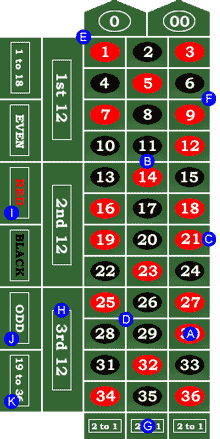In the American roulette it is possible to place 11 types of bets. Each type of bet covers a certain range of numbers, and each type has its own payoff rate.
American roulette table layout and payoffs
Let's look at the table layout. The short lines of three numbers each are called rows on the board, while the longer lines, each holding twelve, are called columns. The first six types of bets are all made on the numbered space or on the lines between them and are called inside bets, while the last five types are made on the special boxes below and to the center of the board and are called outside bets. Types of bets are illustrated and explained in the roulette wheel diagram and table below.
The letters in the blue circles correspond to the letters used in the Example. Bets A to F are called "inside bets". Bets G to K are called "outside bets".
 |
Roulette Inside Bets
Roulette Outside Bets
|
Inside bets
Place your chips directly on any single number (zero and double-zero including). There are 38 possible Straight Up bets. You win if the ball lands on your number.
Example: A (30) Odds: 38:1 Payoff: 35:1
Place your chips on the line between any two numbers. There are 57 possible Split bets. You win if the ball lands on either of those numbers.
Example: B (11 or 14). Odds: 38:2 Payoff: 17:1
Place your chips at the end of any row of numbers on the line that separates the inside and outside betting area.. A street bet covers three numbers (entire row of the table). There are 11 possible Street bets. You win if the ball lands on one of those three numbers.
Example: C (19, 20, 21). Odds: 38:3 Payoff: 11:1
Place your chips at the corner where four numbers meet. All four numbers are covered. There are 22 possible Corner bets. You win if the ball lands on one of those four numbers.
Example: D (25, 26, 28, 29). Odds: 38:4 Payoff: 8:1
This bet can be made in only one place and covers five numbers: zero, double zero, one, two and three. You win if the ball lands on one of those five numbers.
Example: E (0, 00, 1, 2, 3). Odds: 38:5 Payoff: 6:1
Place your chips at the end of two rows at the intersection between them. A line bet covers all the numbers in either row, for a total of six. There are 11 possible Line bets. You win if the ball lands on one of those six numbers.
Example: F (4, 5, 6, 7, 8, 9). Odds: 38:6 Payoff: 5:1
Outside bets
Placing a chip in one of the boxes marked "2 to 1" at the end of the columns covers all the numbers in that column, a total of twelve. Neither the zero nor the double zero are covered by any of the columns. There are 3 possible Column bets. You win if the ball lands on one of 12 numbers of the column.
Example: G (Set of column numbers). Odds: 38:12 Payoff: 2:1
Placing a chip in one of the three boxes marked "1st 12," "2nd 12," or "3rd 12" covers those twelve numbers. There are 3 possible Dozen bets. You win if the ball lands on one of 12 numbers covered.
Example: H (25 through 36). Odds: 38:12 Payoff: 2:1
Red or Black (eighteen numbers)
Place your chip either on the "black" or the "red" field on the outside. This covers all the black or red numbers on the field. The zero and double zero are not covered by any of these boxes. There are 2 possible bets.
Example: I (Red numbers). Odds: 38:18 Payoff: 1:1
Even or Odd (eighteen numbers)
Place your chip either on the "odd" or the "even" field on the outside. Here you bet if the next number that comes up is either even or odd. The zero and double zero are not covered by any of these boxes. There are 2 possible bets.
Example: J (Odd numbers). Odds: 38:18 Payoff: 1:1
Low or High (eighteen numbers)
This bet divides the field of numbers into two groups. The numbers from 1 to 18 (low)and from 19 to 36 (high). You bet on whether the next number that comes up is between 1 and 18 or 19 and 36. In either case if 0 or 00 shows up you lose. There are 2 possible bets.
Example: K (19 through 36). Odds: 38:18 Payoff: 1:1
American roulette
- Rules and object of the game
- Wheel diagram
- Bets and table layout
- Payoffs and house edge